A Low-Cost Energy Monitoring System with Universal Compatibility and Real-Time Visualization for Enhanced Accessibility and Power Savings
Abstract
1. Introduction
- Low cost—the system was indigenously developed using open-source software and packages, and appropriate hardware was selected as per our requirements for a minimal cost.
- User-friendly Multifunctional UI—all the options in the UI were customized and designed carefully, aiming at user preferences and ease, to make the information easily accessible and actionable. The UI was designed keeping the human–computer interface (HCI) in mind. The theme and placement of interactive features were designed and assessed regarding the ease of interaction of the end-user as well as the administrator. The development of the modules is carried out through a modular approach, and the features in each module were designed to encourage behavioral changes towards energy consumption.
- Compatible Hardware—the EnMS’s universal installation capability makes it vendor-independent for energy meters. All energy meters that use Modbus are supported. The firmware was coded dynamically, so that the changing order of the pins of different parameters does not affect the logic of the insert operation on the cloud database.
- Secure—the overall solution was secured by establishing a firewall and secure socket layer (SSL) for encrypted communication between different tiers of the IoT framework. Both device-to-cloud and cloud-to-user communications are end-to-end encrypted to provide complete security for the system.
2. Related Work
3. Design Methodology
3.1. Overall System Architecture
3.2. Technological Breakdown of the Architecture
3.2.1. Energy Monitoring Node
3.2.2. Cloud Architecture
3.2.3. The User Interface (UI)
- Behavior Change: The proposed EnMS architecture allows assisting in changing user behavior by gathering usage patterns and displaying information in a consciously modulating manner. Auto-generated daily and monthly reports are sent to the user by email at the end of each day/month. The daily report contains an energy consumption graph of the day with on-peak and off-peak hours highlighted. The consumption pattern is compared with the same day the previous week, as well as with the temperature of the current day. Conversely, the monthly bill received by the customer at the end of the month from the local energy utility provider has a minimal effect on the consumption behavior of the customer in a reactive manner. As that bill only shows a single bar for the whole month’s consumption, with no peak-hour breakdown. The proposed EnMS generates a monthly report as shown in the Appendix B.Along with these reports, the daily shift graphs also help in monitoring and controlling consumption by allowing the users to make policies for the time of the shifts, as depicted in Figure 6. The shift graphs help in visualizing the energy consumption during the defined shifts of the user. This feature helps in keeping the track of the consumption in the allotted time period. The user can manage and relocate the shifts for efficient management and consumption in a proactive manner.
- Expense Monitoring: The total energy units in terms of kilowatt hours (kWh), as well as on-peak and off-peak, are also shown in numeric form and converted into charges according to the tariff used by the customer. The daily consumption is broken down into on-peak and off-peak units, as well as charges calculating the amount in per-day and hour granularity. The amount is further divided per hour and a pie chart visualizes the contribution of on-peak and off-peak units to the total bill of the day. All this information helps in changing user behavior towards more efficient consumption, in contrast to just a lump sum amount at the end of the month with no breakdown based on per day or hour charges or a separate on-peak and off-peak consumption analysis, as shown in Appendix A. The accumulated billing calculation before the end-of-month helps in visualizing the consumption amount using the tariff provided by the commercial utility provider. The user can select any time period for generating the bill and can monitor upcoming estimated/expected expenses before the actual bill comes. The billing module is depicted in Figure 7.
- Consumption Health: The users are allowed to set up the min and max values of the following parameters for the alarms and warnings thresholds of their consumption. The alarms and warnings when occurring in real-time consumption are locked with the time-stamp, as well as the value above/below the threshold, which helps the customer in monitoring the health of their consumption.
- Feedback on Consumption: The generated reports contain feedback on the energy consumption of the day and month. The pie chart visualizes the bill’s monetary division, as shown in Appendix A. It shows a breakdown in terms of the money making up the whole bill. The ultimate target of the user is to reduce the amount of on-peak bills, so that the total amount of the bill can be reduced. The on-peak ratio is calculated and compared with a predefined chart based on scale division, as shown in Table 4. This interpretation of the ratio of consumption helps the user in reducing their on-peak ratio, so that the overall consumption and billing can be reduced. The on-peak ratio is calculated as shown in Equation (1).
3.3. Security of the Proposed EnMS
4. System Validation and Verification
Case Study
5. Results and Discussion
- C1 (Cost) = price in USD
- C2 (user-friendly) = [access (website + android + iOS) + alerts + BI]
- C3 (compatible HW) = [energy consumption (monitoring + controlling) + granularity (device + building + grid)]
- C4 (security) = Node + Server
6. Conclusions
Author Contributions
Funding
Institutional Review Board Statement
Informed Consent Statement
Data Availability Statement
Conflicts of Interest
Abbreviations
| ADC | Analog-to-Digital Converter |
| AES | Advanced Encryption Standard |
| AJAX | Asynchronous JavaScript and XML |
| API | Application Programming Interface |
| CIA | Confidentiality Integrity Availability |
| CPU | Central Processing Unit |
| CRUD | Create, Read, Update and Delete |
| CSS | Cascading Style Sheet |
| DAQ | Data Acquisition |
| DHCP | Dynamic Host Configuration Protocol |
| DNS | Domain Name Server |
| ECDHE | Elliptic-curve Diffie–Hellman |
| EnMS | Energy Monitoring System |
| GCM | Galois/Counter Mode |
| GUI | Graphical User Interface |
| HCI | Human Computer Interface |
| HTML | Hyper Text Markup Language |
| HTTP | HyperText Transfer Protocol |
| HTTPS | HyperText Transfer Protocol Secure |
| IaaS | Infrastructure as a Service |
| IP | Internet Protocol |
| ISP | Internet Service Provider |
| JSON | JavaScript Object Notation |
| LAMP | Linux, Apache, MySQL, PHP |
| LMIC | Low and Middle-Income Country |
| LTS | Long Term Support |
| MAC | Media Access Control |
| MDPI | Multidisciplinary Digital Publishing Institute |
| ML | Machine Learning |
| PaaS | Platform as a Service |
| PCB | Printed Circuit Board |
| PDO | PHP Data Object |
| PHP | Hypertext Preprocessor |
| PRF | Pseudo-Random Function |
| RAM | Random Access Memory |
| RDBMS | Relational Database Management System |
| RSA | Rivest, Shamir, and Adleman, the inventors of the technique |
| RWD | Responsive Web Design |
| SaaS | Software as a Service |
| SHA-256 | Secure Hash Algorithm 256-bit |
| SMTP | Simple Mail Transfer Protocol |
| SQL | Structured Query Language |
| SSL | Secure Socket Layer |
| TCP | Transmission Control Protocol |
| TLS | Transport Layer Security |
| UDP | User Datagram Protocol |
| UI | User Interface |
| URL | Uniform Resource Locator |
| USB | Universal Serial Bus |
| VPS | Virtual Private Server |
| XML | eXtensible Markup Language |
Appendix A. Daily Energy Consumption Report
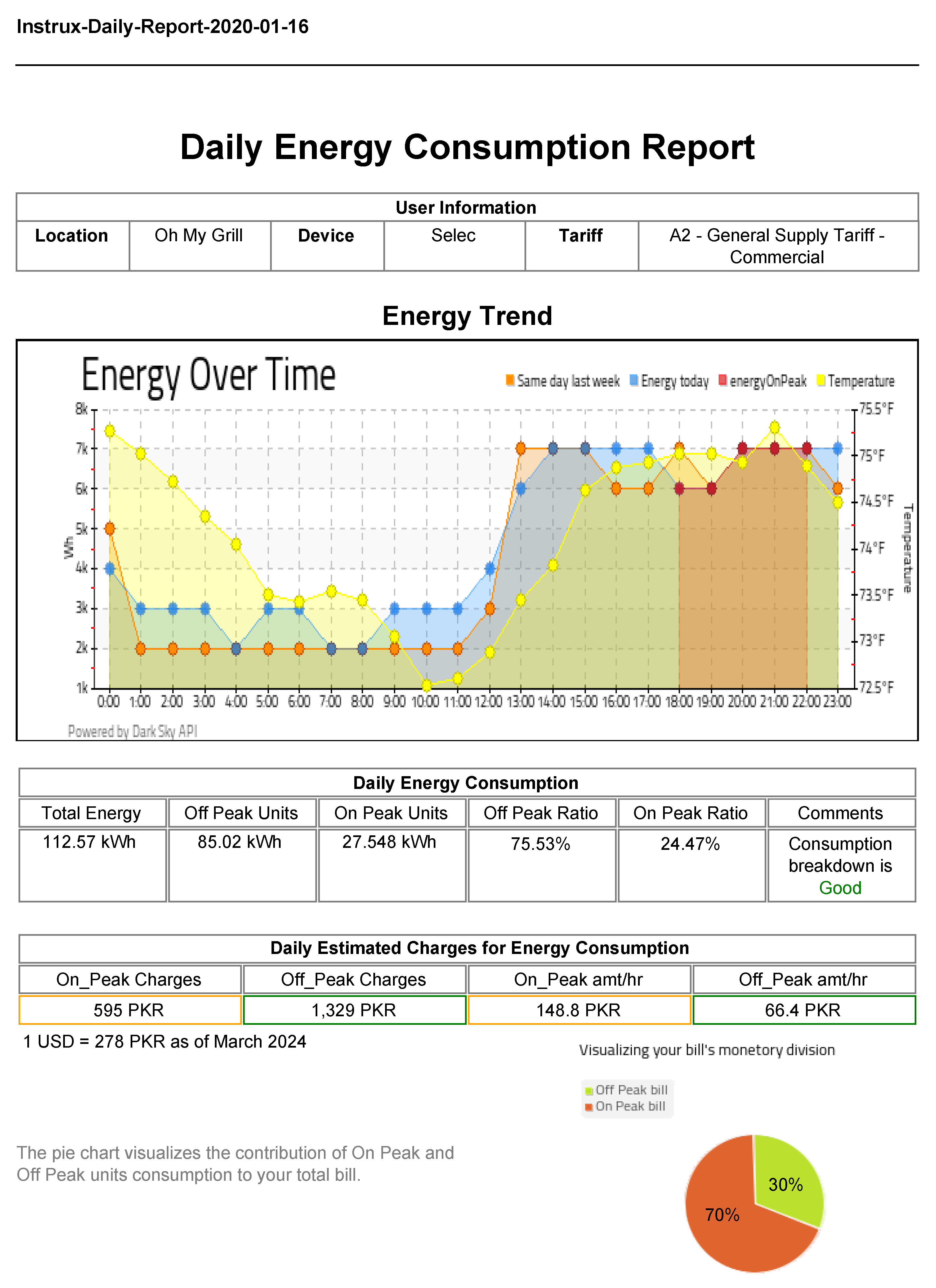
Appendix B. Monthly Energy Consumption Report
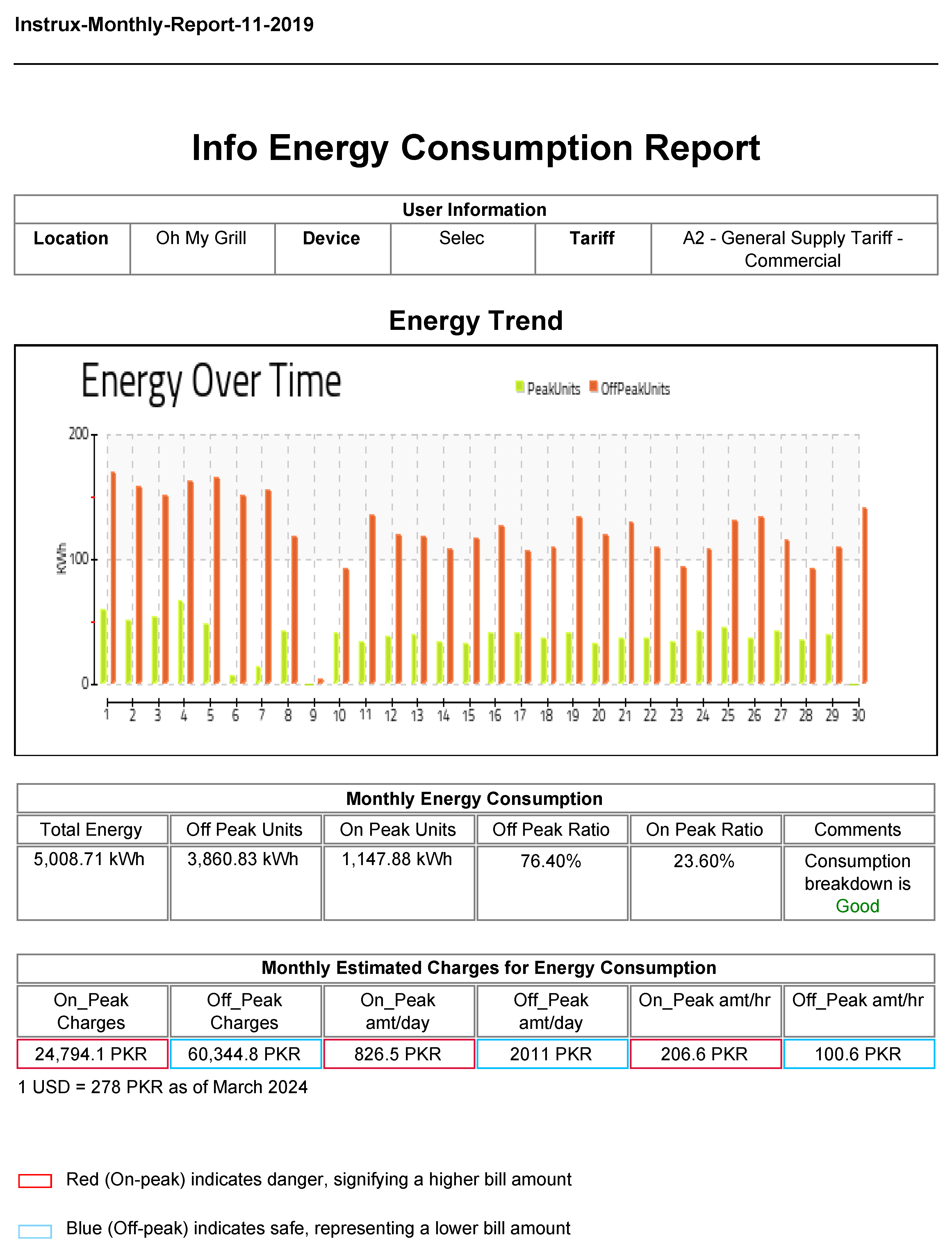
References
- Al-Turjman, F.; Altrjman, C.; Din, S.; Paul, A. Energy monitoring in IoTbased ad hoc networks: An overview. Comput. Electr. Eng. 2019, 76, 133–142. [Google Scholar] [CrossRef]
- Amaxilatis, D.; Akrivopoulos, O.; Mylonas, G.; Chatzigiannakis, I. An IoT-based solution for monitoring a fleet of educational buildings focusing on energy efficiency. Sensors 2017, 17, 2296. [Google Scholar] [CrossRef]
- Cheddadi, Y.; Cheddadi, H.; Cheddadi, F.; Errahimi, F.; Es-sbai, N. Design and implementation of an intelligent low-cost IoT solution for energy monitoring of photovoltaic stations. SN Appl. Sci. 2020, 2, 1165. [Google Scholar] [CrossRef]
- Pereira, R.I.; Dupont, I.M.; Carvalho, P.C.; Jucá, S.C. IoT embedded linux system based on Raspberry Pi applied to real-time cloud monitoring of a decentralized photovoltaic plant. Meas. J. Int. Meas. Confed. 2018, 114, 286–297. [Google Scholar] [CrossRef]
- Pitì, A.; Verticale, G.; Rottondi, C.; Capone, A.; Lo Schiavo, L. The role of smart meters in enabling real-time energy services for households: The Italian case. Energies 2017, 10, 199. [Google Scholar] [CrossRef]
- Fletcher, J.; Malalasekera, W. Development of a user-friendly, low-cost home energy monitoring and recording system. Energy 2016, 111, 32–46. [Google Scholar] [CrossRef]
- Chooruang, K.; Meekul, K. Design of an IoT Energy Monitoring System. In Proceedings of the 2018 16th International Conference on ICT and Knowledge Engineering (ICT&KE), Bangkok, Thailand, 21–23 November 2018; pp. 48–51. [Google Scholar] [CrossRef]
- Taktak, E.; Rodriguez, I.B. Energy Consumption Adaptation Approach for Smart Buildings. In Proceedings of the 2017 IEEE/ACS 14th International Conference on Computer Systems and Applications (AICCSA), Hammamet, Tunisia, 30 October–3 November 2017; IEEE: Piscataway, NJ, USA, 2017; pp. 1370–1377. [Google Scholar]
- Pirbhulal, S.; Zhang, H.; Alahi, M.E.E.; Ghayvat, H.; Mukhopadhyay, S.C.; Zhang, Y.T.; Wu, W. A novel secure IoT-based smart home automation system using a wireless sensor network. Sensors 2017, 17, 69. [Google Scholar] [CrossRef] [PubMed]
- Talal, M.; Zaidan, A.A.; Zaidan, B.B.; Albahri, A.S.; Alamoodi, A.H.; Albahri, O.S.; Alsalem, M.A.; Lim, C.K.; Tan, K.L.; Shir, W.L.; et al. Smart Home-based IoT for Real-time and Secure Remote Health Monitoring of Triage and Priority System using Body Sensors: Multi-driven Systematic Review. J. Med. Syst. 2019, 43, 42. [Google Scholar] [CrossRef]
- Oliver, S.T.; González-Pérez, A.; Guijarro, J.H. An IoT proposal for monitoring vineyards called senviro for agriculture. In Proceedings of the IOT’18: Proceedings of the 8th International Conference on the Internet of Things, Barbara, CA, USA, 15–18 October 2018. [Google Scholar] [CrossRef]
- Tasong, A.C.; Abao, R.P. Design and development of an IoT application with visual analytics for water consumption monitoring. Procedia Comput. Sci. 2019, 157, 205–213. [Google Scholar] [CrossRef]
- Kao, K.C.; Chieng, W.H.; Jeng, S.L. Design and development of an IoTbased web application for an intelligent remote SCADA system. IOP Conf. Ser. Mater. Sci. Eng. 2018, 323, 012025. [Google Scholar] [CrossRef]
- Liu, W.; Tang, R.; Peng, T. An IoT-enabled Approach for Energy Monitoring and Analysis of Die Casting Machines. Procedia CIRP 2018, 69, 656–661. [Google Scholar] [CrossRef]
- Athira, K.; Devidas, A.R.; Ramesh, M.V.; Rangan, V.P. User centered energy management scheme for smart buildings. In Proceedings of the 2017 International Conference on Advances in Computing, Communications and Informatics (ICACCI), Udupi, India, 13–16 September 2017; pp. 1296–1302. [Google Scholar]
- TED: The Energy Detective Website. Available online: http://www.theenergydetective.com/tedprohome.html (accessed on 4 January 2021).
- Wiser Energy, Energy Management System IEC, Schneider Electric. Available online: https://www.se.com/ww/en/product-range-presentation/62107-wiser-energy/?selected-node-id=12147001324#tabs-top (accessed on 4 January 2021).
- Nasroollah, Z.; Moonsamy, I.; Chuttur, Y. A Cloud-Based Energy Monitoring System Using IoT and Machine Learning. In Advances in Intelligent Systems and Computing; Springer: Singapore, 2019; pp. 165–174. [Google Scholar]
- Shivaraman, N.; Saki, S.; Liu, Z.; Ramanathan, S.; Easwaran, A.; Steinhorst, S. Real-Time Energy Monitoring in IoT-enabled Mobile Devices. In Proceedings of the 2020 Design, Automation & Test in Europe Conference & Exhibition (DATE), Grenoble, France, 9–13 March 2020; pp. 991–994. [Google Scholar] [CrossRef]
- Kaman, K.K.; Faramarzi, M.; Ibrahim, S.; Yunus, M.A.M. Artificial neural network for non-intrusive electrical energy monitoring system, Indones. J. Electr. Eng. Comput. Sci. 2017, 6, 124–131. [Google Scholar] [CrossRef][Green Version]
- Karthikeyan, S.; Bhuvaneswari, P.T. IoT based real-time residential energy meter monitoring system. In Proceedings of the 2017 Trends in Industrial Measurement and Automation (TIMA), Chennai, India, 6–8 January 2017. [Google Scholar] [CrossRef]
- Paredes-Valverde, M.A.; Alor-Hernández, G.; García-Alcaráz, J.L.; Salas-Zárate, M.D.P.; Colombo-Mendoza, L.O.; Sánchez-Cervantes, J.L. IntelliHome: An internet of things-based system for electrical energy saving in smart home environment. Comput. Intell. 2020, 36, 203–224. [Google Scholar] [CrossRef]
- Sulistyanto, M.P.; Pranata, K.B.; Afandi, A.N.; Sendari, S.; Sulistiyowati, I. Monitoring electrical energy in electronic energy audits through internet of things technology. J. Phys. Conf. Ser. 2019, 1402, 077067. [Google Scholar] [CrossRef]
- Peng, C.; Huang, J. A home energy monitoring and control system based on ZigBee technology. Int. J. Green Energy 2016, 13, 1615–1623. [Google Scholar] [CrossRef]
- Galera, K.M.E.; Llantos, O.E. Mobile Web Energy Monitoring System Using DFRduino Uno. Procedia Comput. Sci. 2017, 124, 706–713. [Google Scholar] [CrossRef]
- Saleem, M.U.; Shakir, M.; Usman, M.R.; Bajwa, M.H.T.; Shabbir, N.; Shams Ghahfarokhi, P.; Daniel, K. Integrating Smart Energy Management System with Internet of Things and Cloud Computing for Efficient Demand Side Management in Smart Grids. Energies 2023, 16, 4835. [Google Scholar] [CrossRef]
- Rani, D.P.; Suresh, D.; Kapula, P.R.; Akram, C.M.; Hemalatha, N.; Soni, P.K. IoT based smart solar energy monitoring systems. Mater. Today Proc. 2023, 80, 3540–35405. [Google Scholar] [CrossRef]
- Nguyen, T.K.; Dekneuvel, E.; Jacquemod, G.; Nicolle, B.; Zammit, O.; Nguyen, V.C. Development of a real-time non-intrusive appliance load monitoring system: An application level model. Int. J. Electr. Power Energy Syst. 2017, 90, 168–180. [Google Scholar] [CrossRef]
- Froiz-Míguez, I.; Fernández-Caramés, T.; Fraga-Lamas, P.; Castedo, L. Design, Implementation and Practical Evaluation of an IoT Home Automation System for Fog Computing Applications Based on MQTT and ZigBee-WiFi Sensor Nodes. Sensors 2018, 18, 2660. [Google Scholar] [CrossRef]
- Mataloto, B.; Ferreira, J.; Cruz, N. LoBEMS—IoT for Building and Energy Management Systems. Electronics 2019, 8, 763. [Google Scholar] [CrossRef]
- Marinakis, V.; Doukas, H. An advanced IoT-based system for intelligent energy management in buildings. Sensors 2018, 18, 610. [Google Scholar] [CrossRef] [PubMed]
- Chen, X.; Li, C.; Tang, Y.; Xiao, Q. An Internet of Things based energy efficiency monitoring and management system for machining workshop. J. Clean. Prod. 2018, 199, 957–968. [Google Scholar] [CrossRef]
- Suciu, G.; Necula, L.; Iosu, R.; Usurelu, T.; Ceaparu, M. IoT and Cloud-Based Energy Monitoring and Simulation Platform. In Proceedings of the 2019 11th International Symposium on Advanced Topics in Electrical Engineering (ATEE), Bucharest, Romania, 28–30 March 2019; pp. 1–4. [Google Scholar] [CrossRef]
- Rashid, R.A.; Chin, L.; Sarijari, M.A.; Sudirman, R.; Ide, T. Machine Learning for Smart Energy Monitoring of Home Appliances Using IoT. In Proceedings of the 2019 Eleventh International Conference on Ubiquitous and Future Networks (ICUFN), Split, Croatia, 2–5 July 2019. [Google Scholar] [CrossRef]
- Chupong, C.; Plangklang, B. Electricity bill forecasting application by home energy monitoring system. In Proceedings of the 2017 International Electrical Engineering Congress (iEECON), Pattaya, Thailand, 8–10 March 2017. [Google Scholar] [CrossRef]
- Yang, C.T.; Chen, S.T.; Liu, J.C.; Liu, R.H.; Chang, C.L. On construction of an energy monitoring service using big data technology for the smart campus. Clust. Comput. 2020, 23, 265–288. [Google Scholar] [CrossRef]
- Schneider Electric, Home/All Products/Building Automation and Control/Power Monitoring and Control. Available online: https://www.se.com/ww/en/product-category/4100-power-monitoring-and-control/ (accessed on 6 January 2021).
- Elmeasure, V3. Programming Guide 3. Available online: https://www.elmeasure.com/storage/app/media/resources/documents/elmeasure-multifunction-meter-multifunction2r-programming-guide.pdf (accessed on 6 January 2021).
- Crompton Instruments Energy Meter. Available online: https://www.crompton-instruments.com/ (accessed on 6 January 2021).
- Muller Ziegler. Available online: https://mueller-ziegler.de/ (accessed on 6 January 2021).
- Selec, Home/Digital Meters/Energy Meters. Available online: https://www.selec.com/ (accessed on 6 January 2021).
- Tendril Networks Inc. Available online: http://www.tendrilinc.com/ (accessed on 6 January 2021).
- DIY Kyoto. Available online: http://www.diykyoto.com (accessed on 6 January 2021).
- Tweet A Watt. Available online: https://learn.adafruit.com/tweet-a-watt (accessed on 6 January 2021).
- Digi: Digi XBee Smart Plug ZigBee. Available online: https://www.digi.com/products/xbee-rf-solutions/boxed-rf-modems-adapters/xbee-smart-plug-zb (accessed on 6 January 2021).
- Elgato. Available online: https://www.evehome.com/en/eve-energy (accessed on 6 January 2021).
- Ngo, G.C.; Floriza, J.K.I.; Creayla, C.M.C.; Garcia, F.C.C.; Macabebe, E.Q.B. Real-time energy monitoring system for grid-tied Pho- tovoltaic installations. In Proceedings of the TENCON 2015—2015 IEEE Region 10 Conference, Macao, China, 1–4 November 2015; pp. 1–4. [Google Scholar]
- Benghanem, M. Measurement of meteorological data based on wireless data acquisition system monitoring. Appl. Energy 2009, 86, 2651–2660. [Google Scholar] [CrossRef]
- Zuberi, M.A. Peak-Hour Rates to Be Imposed: K-Electric Not to Charge Meter Rent, Bank Fee from Next Billing Cycle. Business Recorder, Karachi. 2019. Available online: https://fp.brecorder.com/2019/05/20190529482005/ (accessed on 6 January 2021).
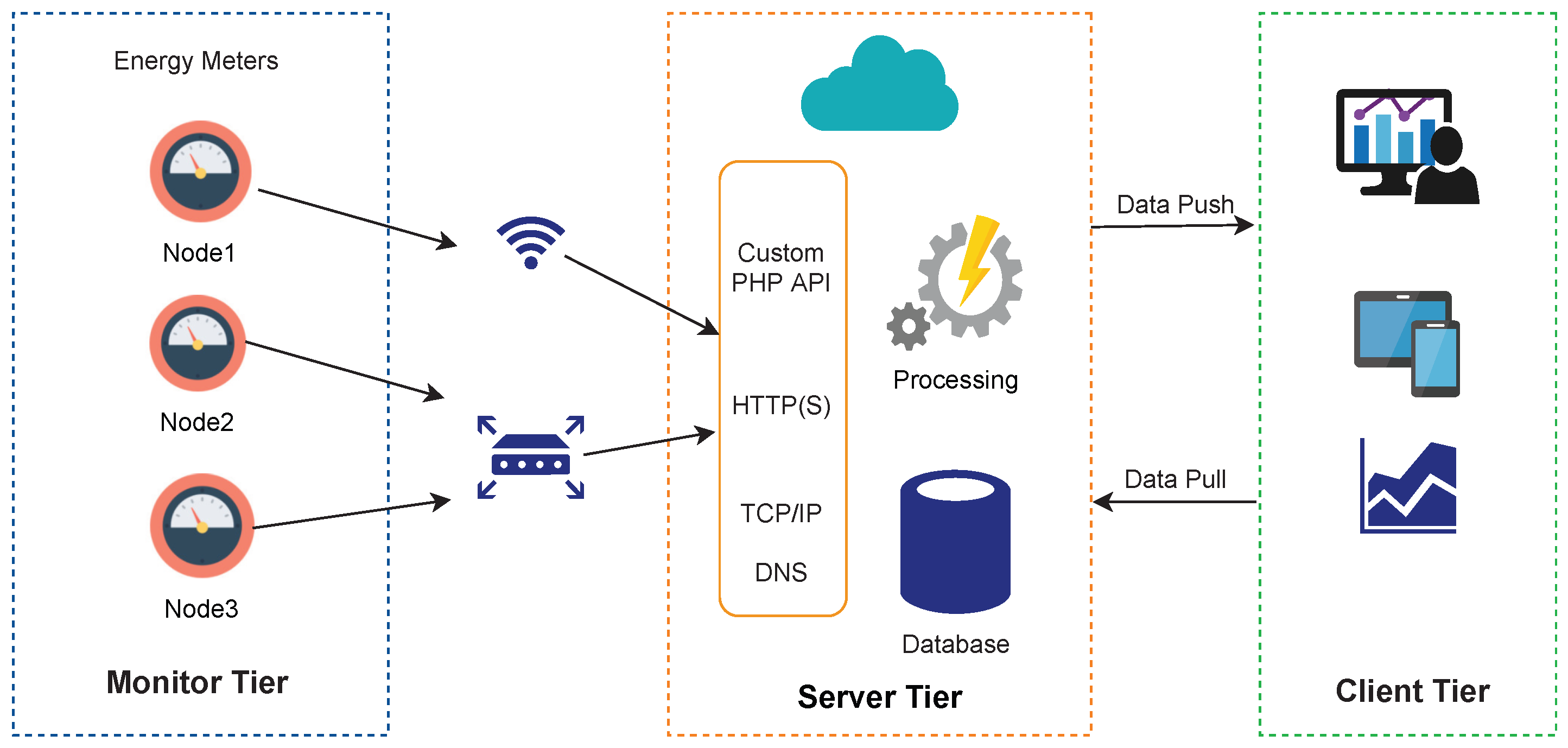

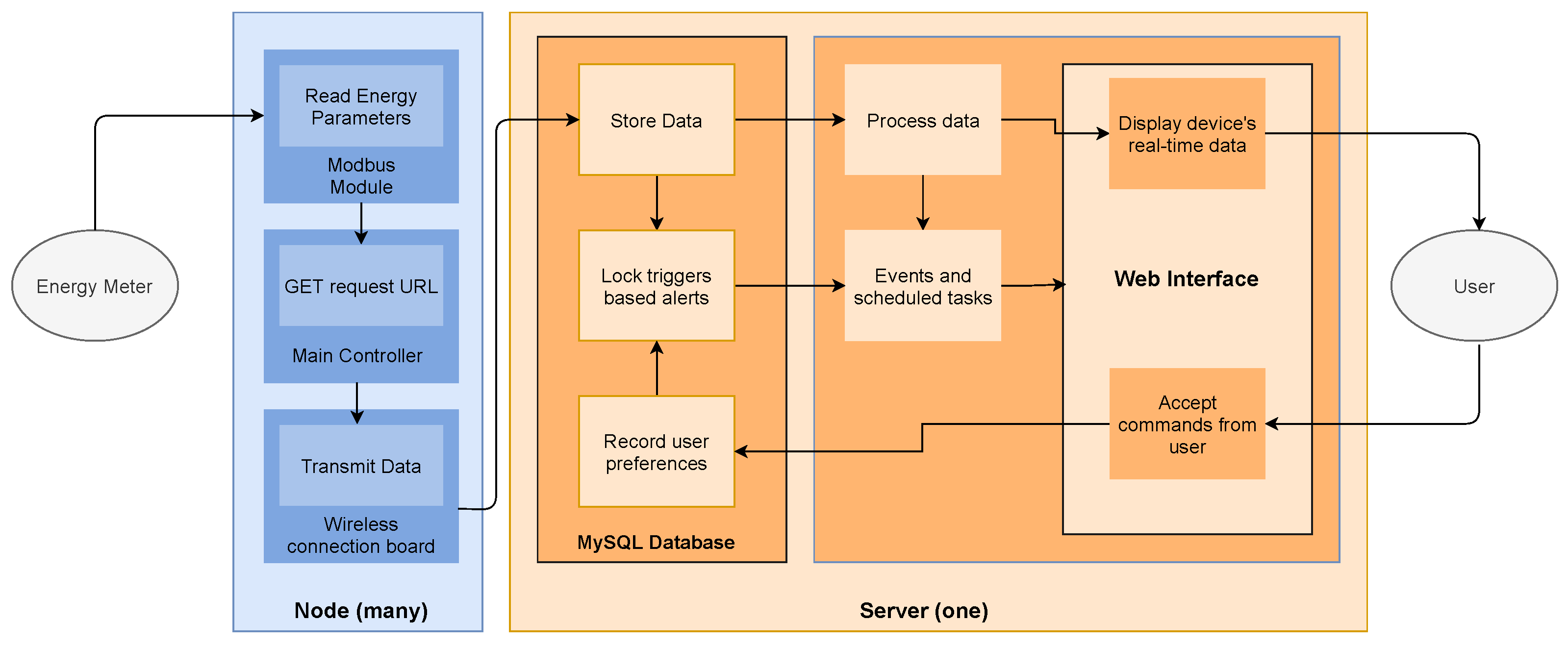
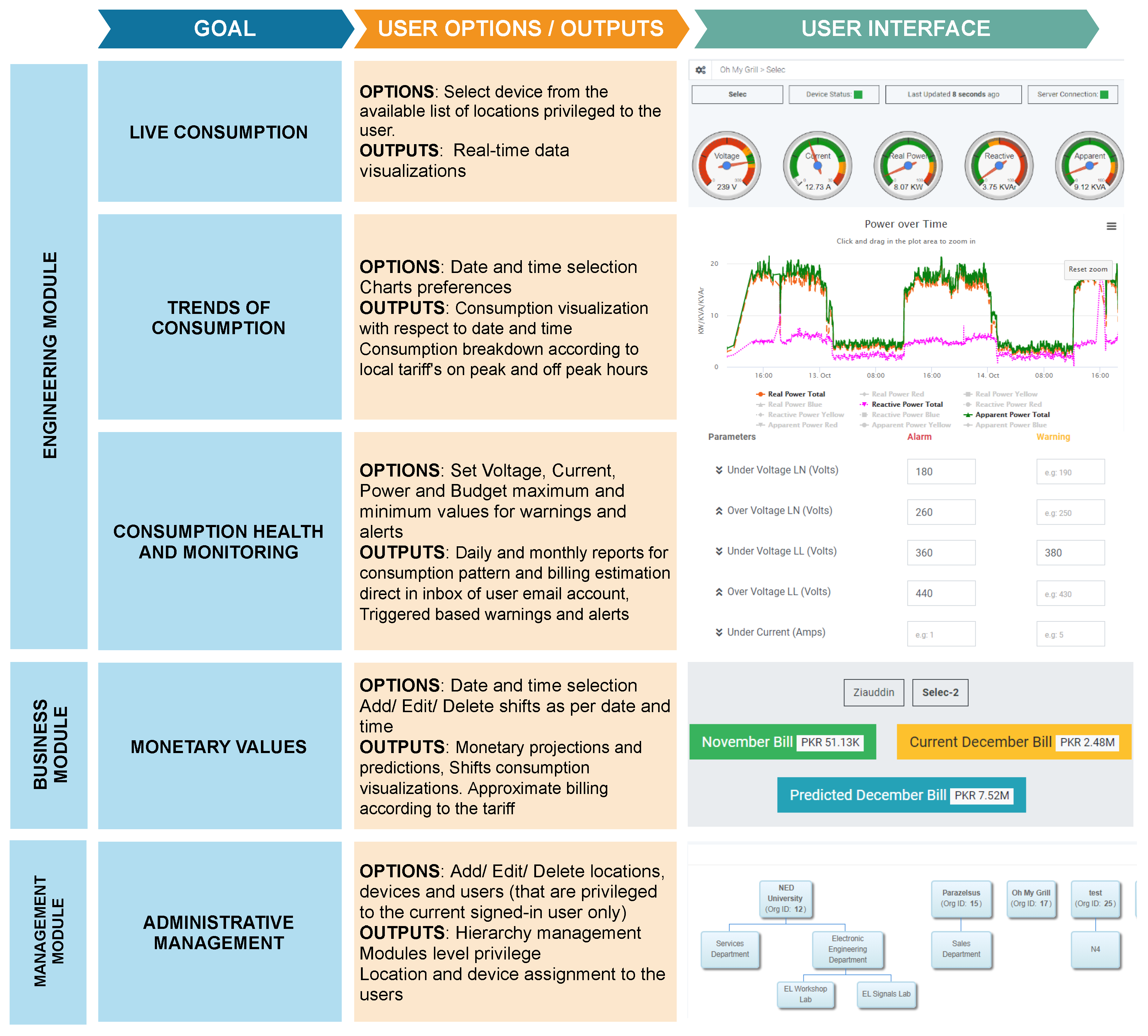

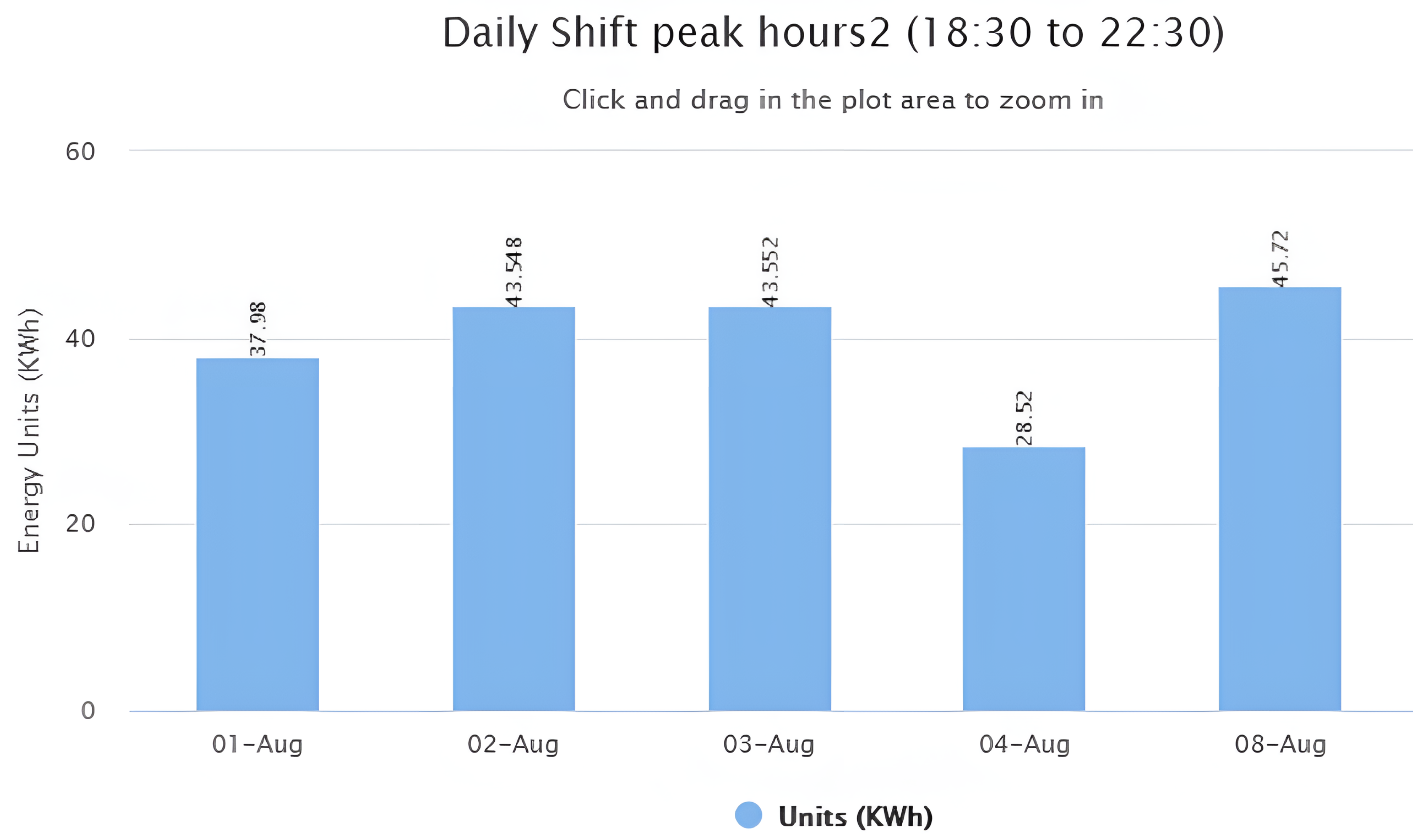
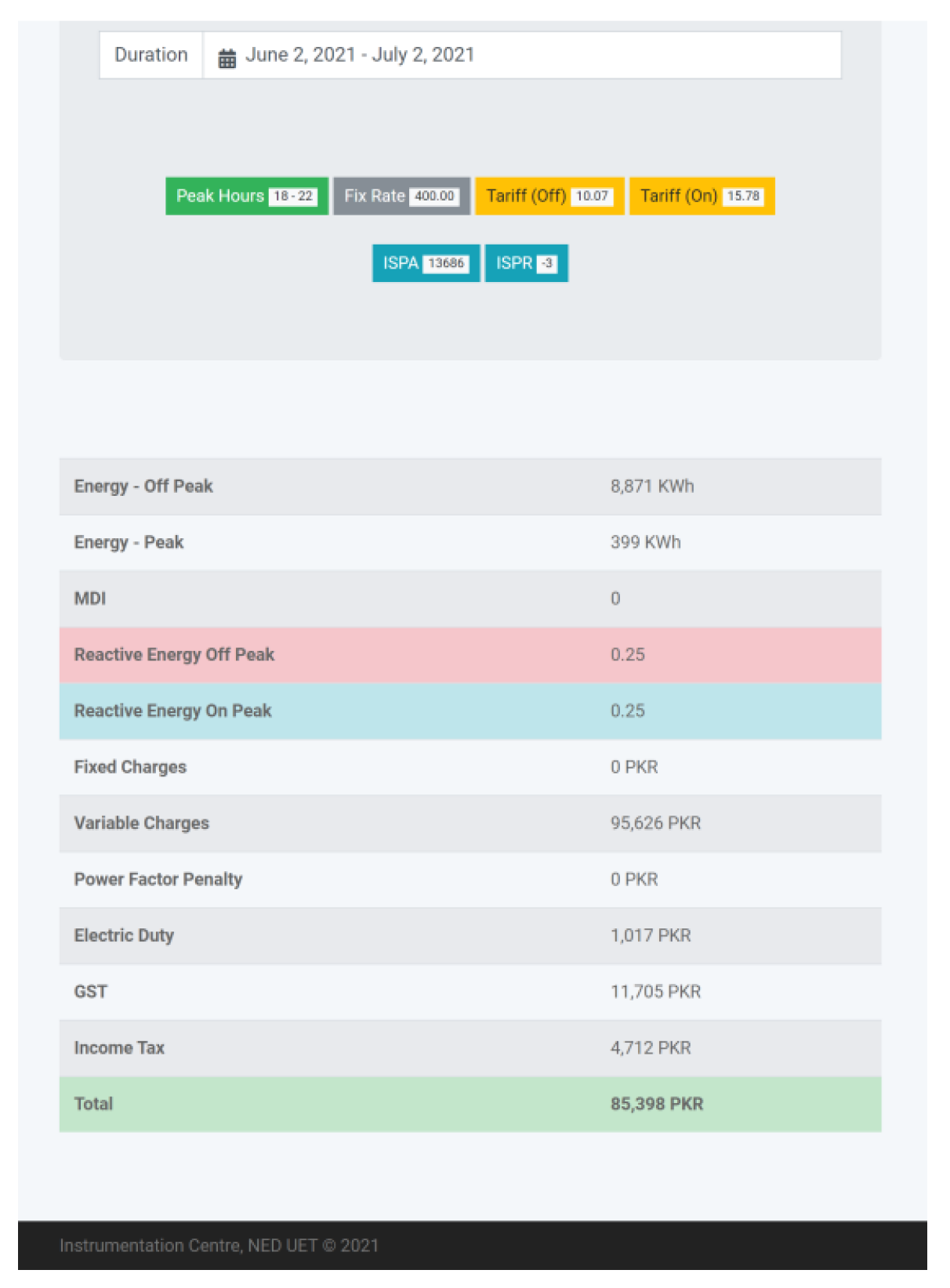
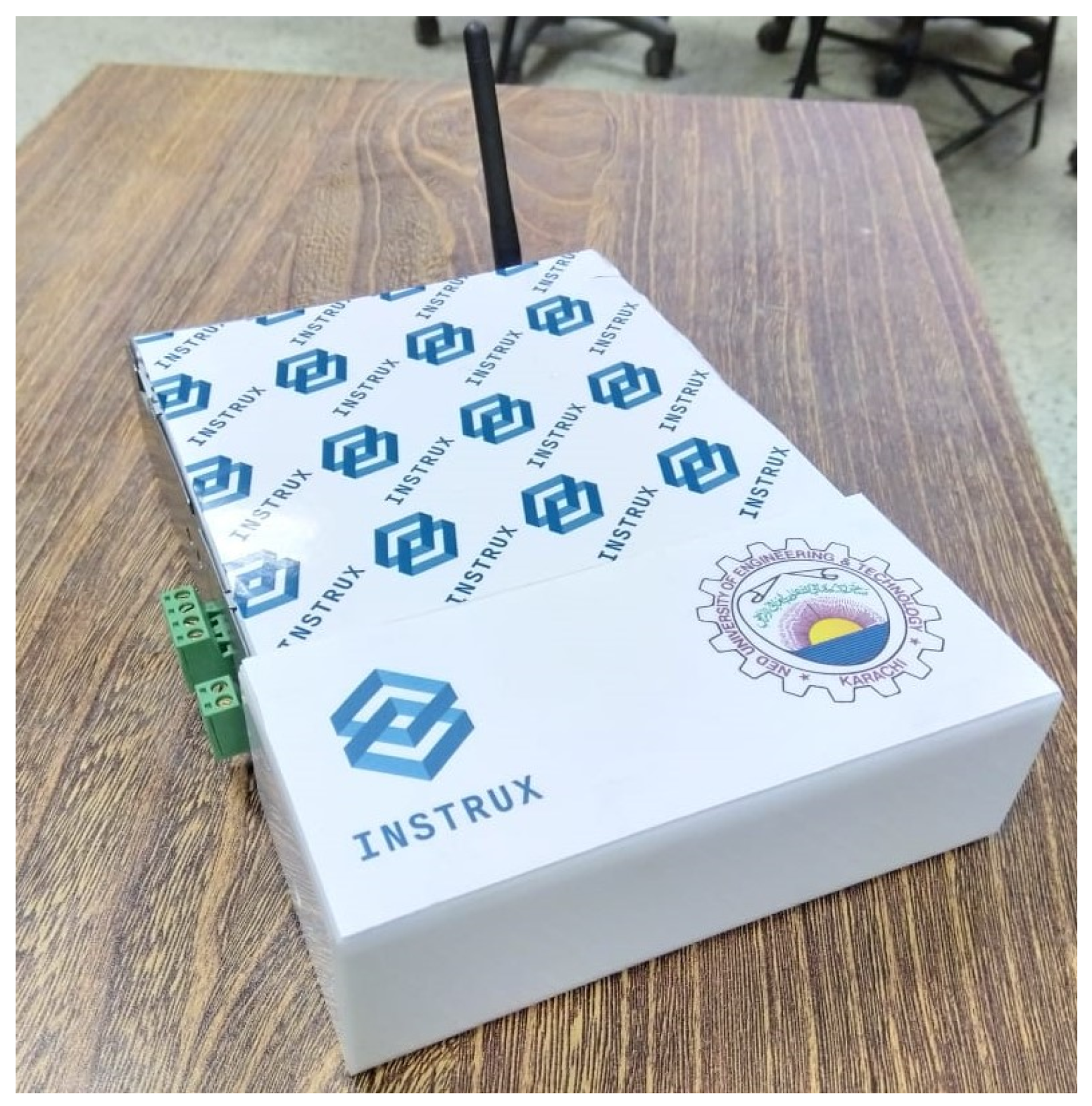
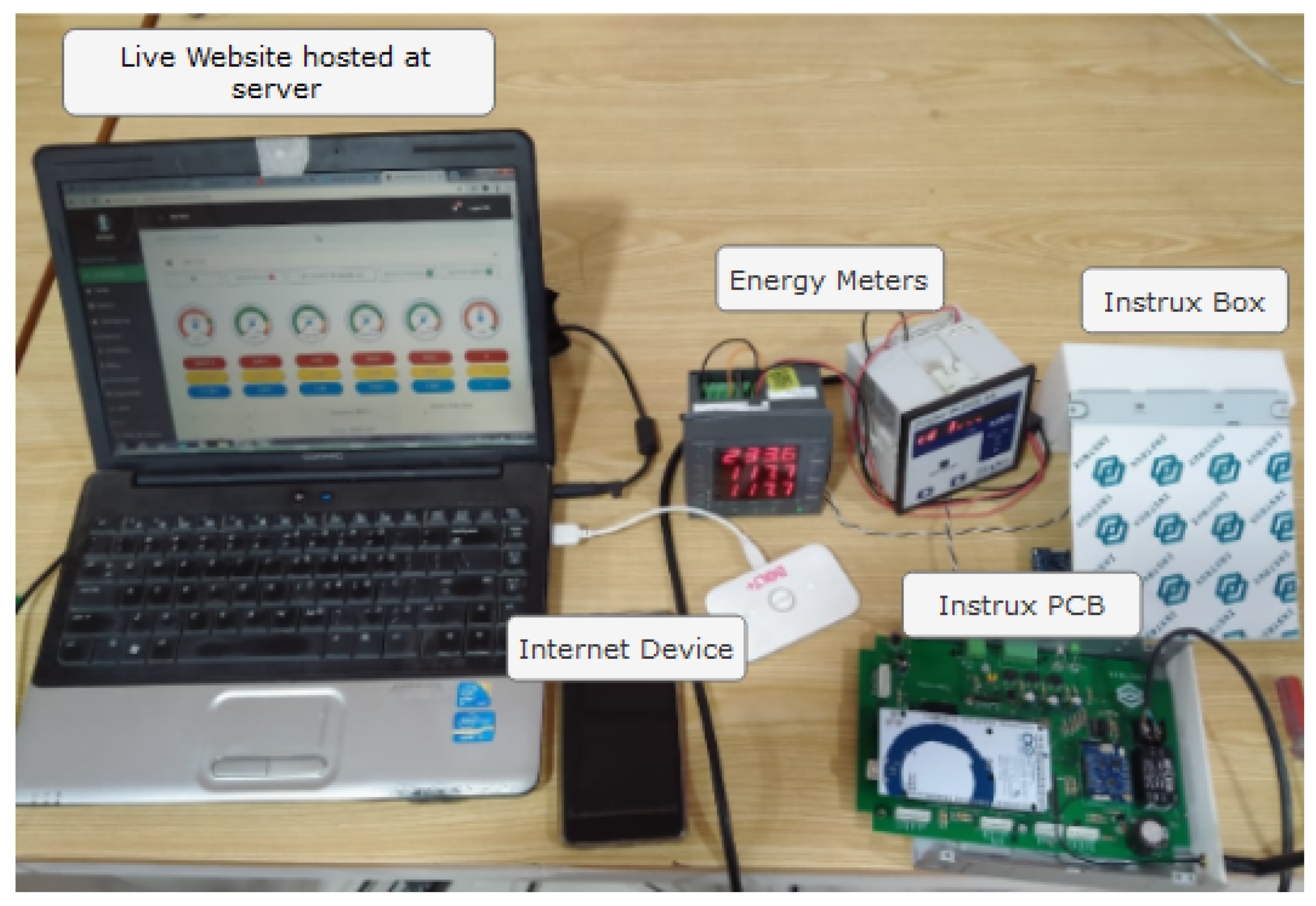
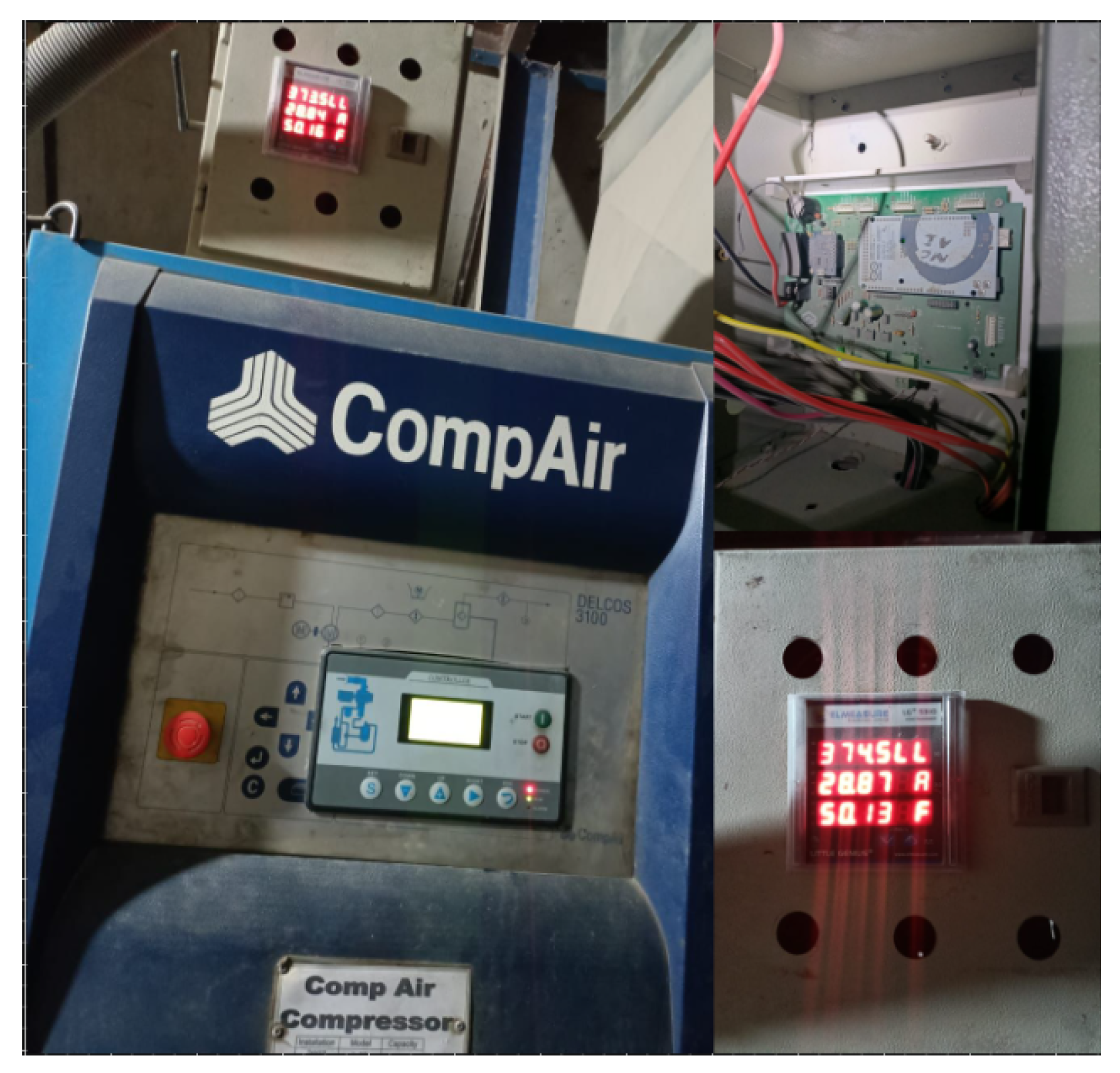
| Circuit Components | Function | Communication Technology |
|---|---|---|
| DAQ card | Interface between Arduino and analog signals | Modbus |
| ESP8266 Wi-Fi Chip | Gives access for Wi-Fi to Arduino board | TCP/IP |
| Arduino Board | Saves the raw data into pre-defined variables, makes a GET request | USB |
| Ethernet Shield | Gives LAN network access to Arduino board | TCP/IP |
| Features | Specifications |
|---|---|
| Memory | 1 GB RAM |
| Processor | a vCPU |
| Data rate | 1 TB transfer |
| Hard disk | 25 GB SSD |
| Cost | 5 USD PM |
| User Experience | Feature |
|---|---|
| Behavior Change | Daily, Monthly energy trend/shifts graph |
| expense monitoring | Estd breakdown of on-peak/off-peak charges, billing before end of month |
| Consumption Health | Alarms and warnings with timestamp and value |
| Feedback on Consumption | consumption ratio, on-peak/off-peak units contribution to the total bill |
| Ratio | Interpretation |
|---|---|
| On Peak Ratio < 0.3 | Good |
| 0.3 < On Peak Ratio < 0.4 | Average |
| 0.4 < On Peak Ratio < 0.3 | Needs Improvement |
| On Peak Ratio > 0.5 | Poor |
| Parameters | Features | Digi XBee Smart Plug Zigbee [45] | Elgato Eve Energy [46] | Tweet A Watt [44] | TED [16] | Wiser Energy [17] | Proposed EnMS |
|---|---|---|---|---|---|---|---|
| Energy Consumption | Monitoring | Yes | Yes | Yes (Sold for $22.99 separately) | Yes | Yes | Yes |
| Controlling | Yes | Yes | No | No | No | No | |
| Communication | Wireless | Yes | Yes | Yes | Yes | Yes | Yes |
| Access | Website | No | No | Yes | Yes | No | Yes |
| Android access | No | No | Yes | Yes | Yes | Yes | |
| iOS access | No | Yes | Yes | Yes | Yes | Yes | |
| Alerts | Alarms and Warnings | No | No | No | Yes | Yes | Yes |
| Business | Billing Intelligence | No | Yes | No | Yes | Yes | Yes |
| Granularity | Implementation Level | Device | Device | Device | Device & Building | Buildings | Building/Grid |
| Price(USD) | 84 | 50 | 40 | 379 | 299 | 125 |
| Work | Characteristics | Microcontroller | Price (USD) |
|---|---|---|---|
| [4,10] | ADC: req. Wi-Fi: built-in Power consumption: High Computation: High Pin Density: Not Applicable Memory: Very High | Raspberry Pi | 49.88 |
| [47] | ADC: req. Wi-Fi: req. Power consumption: High Computation: Very High Pin Density: Not Applicable Memory: Very High | Beagle Bone black | 54.40 |
| [6] | ADC: Integrated Wi-Fi: built-in Power consumption: Low Computation: High Pin Density: High Memory: High | openPicus Flyport | 50.73 |
| [25] | ADC: Integrated Wi-Fi: req. Power consumption: Low Computation: High Pin Density: Low Memory: Low | DFRDuino V3 Microcontroller | 19.9 |
| [48] | ADC: Integrated Wi-Fi: req. Power consumption: Low Computation: Low Pin Density: Moderate Memory: Low | PIC 16F877 | 3.20 |
| [3] | ADC: Integrated Wi-Fi: built-in Power consumption: Low Computation: High Pin Density: Low Memory: Low | ESP 32 | 4.61 |
| [12,21,35] | ADC: Integrated Wi-Fi: built-in Power consumption: Low Computation: Low Pin Density: Low Memory: Low | ESP8266 | 4.11 |
| The Proposed | ADC: Integrated Wi-Fi: req. Power consumption: Low Computation: High Pin Density: High Memory: High | Arduino ATmega2560 | 5.5 |
| Work | Node Security | Server Security | Communication Protocol |
|---|---|---|---|
| [6] | MAC address confirmation | HTTPS | TCP |
| [25] | - | HTTP | - |
| [4] | - | HTTP | MU-MIMO |
| Proposed EnMS | MAC address, password, location confirmation | HTTPS/SSL | TCP/Firewall |
| Work | Platform | Engineering | Business | Management | ||
|---|---|---|---|---|---|---|
| Real-Time | Trends | Billing | User | Remote Node | ||
| [9] | Website (hosted) | ✓ | ✓ | |||
| [33] | Dashboard (local) | ✓ | ||||
| [23] | Website (hosted) | ✓ | ||||
| [19] | Website (hosted) | ✓ | ||||
| [21] | Mobile app | ✓ | ||||
| [3] | Website (hosted) | ✓ | ||||
| [36] | Website (hosted) | ✓ | ||||
| [22] | Mobile app | ✓ | ||||
| [35] | Mobile app | ✓ | ||||
| [30] | Website (hosted) | ✓ | ✓ | ✓ | ||
| [26] | Website (hosted) | ✓ | ✓ | ✓ | ✓ | |
| Proposed EnMS | Website (hosted) | ✓ | ✓ | ✓ | ✓ | ✓ |
| Scale | Range | Interpretation |
|---|---|---|
| 5 | 4.6–5 | Excellent |
| 4 | 3.7–4.5 | Very Good |
| 3 | 2.8–3.6 | Good |
| 2 | 1.9–2.7 | Fair |
| 1 | 1.0–1.8 | Poor |
| Questions | 5 | 4 | 3 | 2 | 1 | Total | Mean | Interpretation |
|---|---|---|---|---|---|---|---|---|
| I found the web interface easy to use | 13 | 4 | 3 | 0 | 0 | 20 | 4.5 | Excellent |
| All the functions (historical trends, billings, consumption comparisons) I expected were presented in understandable form | 6 | 12 | 2 | 0 | 0 | 20 | 4.2 | Very Good |
| The UI is organized and well managed | 17 | 3 | 0 | 0 | 0 | 20 | 4.8 | Excellent |
| The website does not lag or crash | 5 | 10 | 4 | 0 | 1 | 20 | 4.0 | Very Good |
| The colour scheme and theme are consistent | 16 | 4 | 0 | 0 | 0 | 20 | 4.8 | Excellent |
| The navigation options are self-explanatory | 10 | 10 | 0 | 0 | 0 | 20 | 4.5 | Excellent |
| The navigation options are easily available | 16 | 4 | 0 | 0 | 0 | 20 | 4.8 | Excellent |
| The interactive visualizations (bar graphs, line charts) are easily interpretative | 16 | 4 | 0 | 0 | 0 | 20 | 4.8 | Excellent |
| Average Mean | 4.5 | Very Good |
Disclaimer/Publisher’s Note: The statements, opinions and data contained in all publications are solely those of the individual author(s) and contributor(s) and not of MDPI and/or the editor(s). MDPI and/or the editor(s) disclaim responsibility for any injury to people or property resulting from any ideas, methods, instructions or products referred to in the content. |
© 2024 by the authors. Licensee MDPI, Basel, Switzerland. This article is an open access article distributed under the terms and conditions of the Creative Commons Attribution (CC BY) license (https://creativecommons.org/licenses/by/4.0/).
Share and Cite
Khan, H.R.; Kazmi, M.; Lubaba; Khalid, M.H.B.; Alam, U.; Arshad, K.; Assaleh, K.; Qazi, S.A. A Low-Cost Energy Monitoring System with Universal Compatibility and Real-Time Visualization for Enhanced Accessibility and Power Savings. Sustainability 2024, 16, 4137. https://doi.org/10.3390/su16104137
Khan HR, Kazmi M, Lubaba, Khalid MHB, Alam U, Arshad K, Assaleh K, Qazi SA. A Low-Cost Energy Monitoring System with Universal Compatibility and Real-Time Visualization for Enhanced Accessibility and Power Savings. Sustainability. 2024; 16(10):4137. https://doi.org/10.3390/su16104137
Chicago/Turabian StyleKhan, Hashim Raza, Majida Kazmi, Lubaba, Muhammad Hashir Bin Khalid, Urooj Alam, Kamran Arshad, Khaled Assaleh, and Saad Ahmed Qazi. 2024. "A Low-Cost Energy Monitoring System with Universal Compatibility and Real-Time Visualization for Enhanced Accessibility and Power Savings" Sustainability 16, no. 10: 4137. https://doi.org/10.3390/su16104137
APA StyleKhan, H. R., Kazmi, M., Lubaba, Khalid, M. H. B., Alam, U., Arshad, K., Assaleh, K., & Qazi, S. A. (2024). A Low-Cost Energy Monitoring System with Universal Compatibility and Real-Time Visualization for Enhanced Accessibility and Power Savings. Sustainability, 16(10), 4137. https://doi.org/10.3390/su16104137









